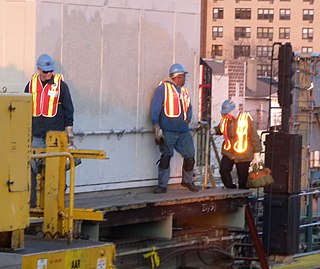Related Research Articles

The International Labour Organization (ILO) is a United Nations agency whose mandate is to advance social and economic justice by setting international labour standards. Founded in October 1919 under the League of Nations, it is one of the first and oldest specialised agencies of the UN. The ILO has 187 member states: 186 out of 193 UN member states plus the Cook Islands. It is headquartered in Geneva, Switzerland, with around 40 field offices around the world, and employs some 3,381 staff across 107 nations, of whom 1,698 work in technical cooperation programmes and projects.
Labour laws, labour code or employment laws are those that mediate the relationship between workers, employing entities, trade unions, and the government. Collective labour law relates to the tripartite relationship between employee, employer, and union.
The Occupational Safety and Health Administration is a regulatory agency of the United States Department of Labor that originally had federal visitorial powers to inspect and examine workplaces. The United States Congress established the agency under the Occupational Safety and Health Act, which President Richard M. Nixon signed into law on December 29, 1970. OSHA's mission is to "assure safe and healthy working conditions for working men and women by setting and enforcing standards and by providing training, outreach, education, and assistance." The agency is also charged with enforcing a variety of whistleblower statutes and regulations. OSHA's workplace safety inspections have been shown to reduce injury rates and injury costs without adverse effects on employment, sales, credit ratings, or firm survival.

A construction worker is a worker employed in the physical construction of the built environment and its infrastructure.
Labor rights or workers' rights are both legal rights and human rights relating to labor relations between workers and employers. These rights are codified in national and international labor and employment law. In general, these rights influence working conditions in the relations of employment. One of the most prominent is the right to freedom of association, otherwise known as the right to organize. Workers organized in trade unions exercise the right to collective bargaining to improve working conditions.
The Labour Inspection Convention, 1947 , also referred to as ILO Convention no. 81 or C081, is a governance convention adopted by the International Labour Organization on July 11, 1947. It entered into force on April 7, 1950 and has been ratified by 148 of the 186 ILO member states as of 2021. The convention sets out principles concerning the organization, functions, and operation of labour inspection systems to ensure enforcement of national laws related to working conditions and worker protections in the commercial and industrial sectors. A Protocol adopted in 1995 expands the coverage of Convention No. 81 to non-commercial or industrial sectors.
Occupational Health Services Convention, 1985 is an International Labour Organization Convention.
Safety and Health in Mines Convention, 1995 is an International Labour Organization Convention. It was adopted at the 82nd International Labour Conference (ILC) of the International Labour Organization (ILO). The ILO is an agency under the United Nations that deals with international labor issues while promoting workers rights and opportunities. One of ILO's goals is to hold annual labor conventions to create legally binding contracts for participating nations to ratify. During the Safety and Health in Mines Convention (C176), it was recognized that there are inherent hazards in the mining workplace, and a need for a convention was mandatory.
The International Commission on Occupational Health (ICOH) is an international non-governmental professional society, founded in Milan during the Expo 1906 as the Permanent Commission on Occupational Health.
A safety management system (SMS) is a management system designed to manage occupational safety and health risks in the workplace. If the system contains elements elements of management of longer-term health impacts and occupational disease, it may be referred to as a safety and health management system (SHMS) or health and safety management system.
An occupational fatality is a death that occurs while a person is at work or performing work related tasks. Occupational fatalities are also commonly called "occupational deaths" or "work-related deaths/fatalities" and can occur in any industry or occupation.

The Maritime Labour Convention (MLC) is an International Labour Organization (ILO) convention, number 186, established in 2006 as the fourth pillar of international maritime law and embodies "all up-to-date standards of existing international maritime labour Conventions and Recommendations, as well as the fundamental principles to be found in other international labour Conventions". The other pillars are the SOLAS, STCW and MARPOL. The treaties applies to all ships entering the harbours of parties to the treaty (port states), as well as to all ships flying the flag of state party (flag states, as of 2021: over 91 per cent).

Occupational safety and health (OSH) or occupational health and safety (OHS) is a multidisciplinary field concerned with the safety, health, and welfare of people at work. OSH is related to the fields of occupational medicine and occupational hygiene and aligns with workplace health promotion initiatives. OSH also protects all the general public who may be affected by the occupational environment.
Child labor in the Philippines is the employment of children in hazardous occupations below the age of fifteen (15), or without the proper conditions and requirements below the age of fifteen (15), where children are compelled to work on a regular basis to earn a living for themselves and their families, and as a result are disadvantaged educationally and socially. So to make it short, it is called child labor when it is forced.
International labour law is the body of rules spanning public and private international law which concern the rights and duties of employees, employers, trade unions and governments in regulating Work and the workplace. The International Labour Organization and the World Trade Organization have been the main international bodies involved in reforming labour markets. The International Monetary Fund and the World Bank have indirectly driven changes in labour policy by demanding structural adjustment conditions for receiving loans or grants. Issues regarding Conflict of laws arise, determined by national courts, when people work in more than one country, and supra-national bodies, particularly in the law of the European Union, have a growing body of rules regarding labour rights.
The SA8000 Standard is an auditable certification standard that encourages organizations to develop, maintain, and apply socially acceptable practices in the workplace. It was developed in 1989 by Social Accountability International, formerly the Council on Economic Priorities, by an advisory board consisting of trade unions, NGOs, civil society organizations and companies. The SA8000's criteria were developed from various industry and corporate codes to create a common standard for social welfare compliance. The current (2014) version of the standard is built on earlier 2001, 2004 and 2008 versions.
Tanzania has a number of laws and regulations that govern occupational safety and health (OSH) protections for workers. The International Labour Organization reports that due to insufficient statistics and consistent reporting, it is impossible to determine the number of workplace accidents that occur in the country.
Diving regulations are the stipulations of the delegated legislation regarding the practice of underwater diving. They apply within the national territory and territorial waters of a country. In most cases they apply to occupational diving, but in a few cases also to recreational diving. There are exemptions for recreational diving in some cases where it is recognised as a self-regulated industry. Offshore diving is generally outside the scope of diving regulations, and tends to be self-regulated through voluntary membership of industry organisations.
OSHliteracy or Occupational Safety and Health Literacy is the degree to which individuals have the functional capacity to access, process and utilize the Occupational Safety and Health (OSH) information and services needed to eliminate or reduce risk.
References
- ↑ https://www.ilo.org/wcmsp5/groups/public/---ed_dialogue/---sector/documents/normativeinstrument/wcms_161135.pdf%5B%5D
- ↑ Ncube, France; Kanda, Artwell (December 2018). "Current Status and the Future of Occupational Safety and Health Legislation in Low- and Middle-Income Countries". Safety and Health at Work. 9 (4): 365–371. doi:10.1016/j.shaw.2018.01.007. PMC 6284162 . PMID 30559983.